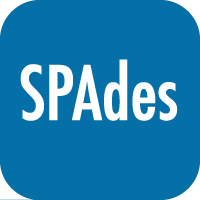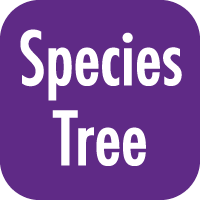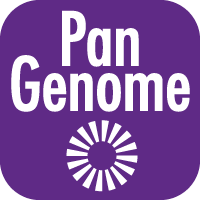The RAST algorithm was applied to annotating an existing genome: Staphylococcus succinus.
The sequence for this genome is comprised of 1 contigs containing 2745675 nucleotides.
The input genome has 2540 existing coding features and 176 existing non-coding features.
Input genome has the following feature types:
Non-coding gene 80
Non-coding misc_feature 1
Non-coding ncRNA 3
Non-coding rRNA 19
Non-coding regulatory 15
Non-coding tRNA 57
Non-coding tmRNA 1
gene 2540
The existing gene features were cleared due to selection of gene calling with Glimmer3 or Prodigal.
The existing gene features were cleared due to selection of gene calling with Glimmer3 or Prodigal.
Standard features were called using: glimmer3; prodigal.
A scan was conducted for the following additional feature types: rRNA; tRNA; selenoproteins; pyrrolysoproteins; repeat regions; crispr.
The genome features were functionally annotated using the following algorithm(s): Kmers V2; Kmers V1; protein similarity.
In addition to the remaining original 0 coding features and 176 non-coding features, 2709 new features were called, of which 101 are non-coding.
Output genome has the following feature types:
Coding gene 2608
Non-coding gene 80
Non-coding misc_feature 1
Non-coding ncRNA 3
Non-coding prophage 3
Non-coding rRNA 19
Non-coding regulatory 15
Non-coding repeat 18
Non-coding rna 80
Non-coding tRNA 57
Non-coding tmRNA 1
Overall, the genes have 2051 distinct functions.
The genes include 1216 genes with a SEED annotation ontology across 1057 distinct SEED functions.
The number of distinct functions can exceed the number of genes because some genes have multiple functions.
Staphylococcus_succinus__GCF_001902315.1_ succeeded!
The RAST algorithm was applied to annotating an existing genome: Staphylococcus equorum.
The sequence for this genome is comprised of 1 contigs containing 2822193 nucleotides.
The input genome has 2635 existing coding features and 185 existing non-coding features.
Input genome has the following feature types:
Non-coding gene 84
Non-coding ncRNA 3
Non-coding rRNA 22
Non-coding regulatory 15
Non-coding repeat_region 2
Non-coding tRNA 58
Non-coding tmRNA 1
gene 2635
The existing gene features were cleared due to selection of gene calling with Glimmer3 or Prodigal.
The existing gene features were cleared due to selection of gene calling with Glimmer3 or Prodigal.
Standard features were called using: glimmer3; prodigal.
A scan was conducted for the following additional feature types: rRNA; tRNA; selenoproteins; pyrrolysoproteins; repeat regions; crispr.
The genome features were functionally annotated using the following algorithm(s): Kmers V2; Kmers V1; protein similarity.
In addition to the remaining original 0 coding features and 185 non-coding features, 2864 new features were called, of which 155 are non-coding.
Output genome has the following feature types:
Coding gene 2709
Non-coding crispr_array 2
Non-coding crispr_repeat 17
Non-coding crispr_spacer 15
Non-coding gene 84
Non-coding ncRNA 3
Non-coding prophage 2
Non-coding rRNA 22
Non-coding regulatory 15
Non-coding repeat 36
Non-coding repeat_region 2
Non-coding rna 83
Non-coding tRNA 58
Non-coding tmRNA 1
Overall, the genes have 2094 distinct functions.
The genes include 1237 genes with a SEED annotation ontology across 1060 distinct SEED functions.
The number of distinct functions can exceed the number of genes because some genes have multiple functions.
Staphylococcus_equorum__GCF_001432245.1_ succeeded!
The RAST algorithm was applied to annotating an existing genome: Staphylococcus saprophyticus.
The sequence for this genome is comprised of 76 contigs containing 2419582 nucleotides.
The input genome has 2370 existing coding features and 55 existing non-coding features.
Input genome has the following feature types:
Non-coding gene 22
Non-coding ncRNA 3
Non-coding rRNA 3
Non-coding regulatory 11
Non-coding tRNA 15
Non-coding tmRNA 1
gene 2370
The existing gene features were cleared due to selection of gene calling with Glimmer3 or Prodigal.
The existing gene features were cleared due to selection of gene calling with Glimmer3 or Prodigal.
Standard features were called using: glimmer3; prodigal.
A scan was conducted for the following additional feature types: rRNA; tRNA; selenoproteins; pyrrolysoproteins; repeat regions; crispr.
The genome features were functionally annotated using the following algorithm(s): Kmers V2; Kmers V1; protein similarity.
In addition to the remaining original 0 coding features and 55 non-coding features, 2481 new features were called, of which 51 are non-coding.
Output genome has the following feature types:
Coding gene 2430
Non-coding gene 22
Non-coding ncRNA 3
Non-coding rRNA 3
Non-coding regulatory 11
Non-coding repeat 34
Non-coding rna 17
Non-coding tRNA 15
Non-coding tmRNA 1
Overall, the genes have 1899 distinct functions.
The genes include 1168 genes with a SEED annotation ontology across 1005 distinct SEED functions.
The number of distinct functions can exceed the number of genes because some genes have multiple functions.
Staphylococcus_saprophyticus__GCF_001074355.1_ succeeded!
The RAST algorithm was applied to annotating an existing genome: Staphylococcus capitis subsp. capitis.
The sequence for this genome is comprised of 2 contigs containing 2503265 nucleotides.
The input genome has 2329 existing coding features and 183 existing non-coding features.
Input genome has the following feature types:
Non-coding gene 85
Non-coding ncRNA 3
Non-coding rRNA 19
Non-coding regulatory 13
Non-coding tRNA 62
Non-coding tmRNA 1
gene 2329
The existing gene features were cleared due to selection of gene calling with Glimmer3 or Prodigal.
The existing gene features were cleared due to selection of gene calling with Glimmer3 or Prodigal.
Standard features were called using: glimmer3; prodigal.
A scan was conducted for the following additional feature types: rRNA; tRNA; selenoproteins; pyrrolysoproteins; repeat regions; crispr.
The genome features were functionally annotated using the following algorithm(s): Kmers V2; Kmers V1; protein similarity.
In addition to the remaining original 0 coding features and 183 non-coding features, 2491 new features were called, of which 101 are non-coding.
Output genome has the following feature types:
Coding gene 2390
Non-coding gene 85
Non-coding ncRNA 3
Non-coding prophage 2
Non-coding rRNA 19
Non-coding regulatory 13
Non-coding repeat 18
Non-coding rna 81
Non-coding tRNA 62
Non-coding tmRNA 1
Overall, the genes have 2017 distinct functions.
The genes include 1097 genes with a SEED annotation ontology across 1010 distinct SEED functions.
The number of distinct functions can exceed the number of genes because some genes have multiple functions.
Staphylococcus_capitis_subsp._capitis__GCF_001028645.1_ succeeded!
The RAST algorithm was applied to annotating an existing genome: Staphylococcus cohnii subsp. cohnii.
The sequence for this genome is comprised of 16 contigs containing 2826849 nucleotides.
The input genome has 2677 existing coding features and 170 existing non-coding features.
Input genome has the following feature types:
Non-coding gene 78
Non-coding ncRNA 3
Non-coding rRNA 17
Non-coding regulatory 14
Non-coding tRNA 57
Non-coding tmRNA 1
gene 2677
The existing gene features were cleared due to selection of gene calling with Glimmer3 or Prodigal.
The existing gene features were cleared due to selection of gene calling with Glimmer3 or Prodigal.
Standard features were called using: glimmer3; prodigal.
A scan was conducted for the following additional feature types: rRNA; tRNA; selenoproteins; pyrrolysoproteins; repeat regions; crispr.
The genome features were functionally annotated using the following algorithm(s): Kmers V2; Kmers V1; protein similarity.
In addition to the remaining original 0 coding features and 170 non-coding features, 2891 new features were called, of which 135 are non-coding.
Output genome has the following feature types:
Coding gene 2756
Non-coding gene 78
Non-coding ncRNA 3
Non-coding prophage 1
Non-coding rRNA 17
Non-coding regulatory 14
Non-coding repeat 64
Non-coding rna 70
Non-coding tRNA 57
Non-coding tmRNA 1
Overall, the genes have 2075 distinct functions.
The genes include 1297 genes with a SEED annotation ontology across 1041 distinct SEED functions.
The number of distinct functions can exceed the number of genes because some genes have multiple functions.
Staphylococcus_cohnii_subsp._cohnii__GCF_000972575.1_ succeeded!
The RAST algorithm was applied to annotating an existing genome: Staphylococcus gallinarum.
The sequence for this genome is comprised of 272 contigs containing 3171720 nucleotides.
The input genome has 3095 existing coding features and 194 existing non-coding features.
Input genome has the following feature types:
Non-coding gene 89
Non-coding ncRNA 3
Non-coding rRNA 28
Non-coding regulatory 16
Non-coding tRNA 57
Non-coding tmRNA 1
gene 3095
The existing gene features were cleared due to selection of gene calling with Glimmer3 or Prodigal.
The existing gene features were cleared due to selection of gene calling with Glimmer3 or Prodigal.
Standard features were called using: glimmer3; prodigal.
A scan was conducted for the following additional feature types: rRNA; tRNA; selenoproteins; pyrrolysoproteins; repeat regions; crispr.
The genome features were functionally annotated using the following algorithm(s): Kmers V2; Kmers V1; protein similarity.
In addition to the remaining original 0 coding features and 194 non-coding features, 3667 new features were called, of which 439 are non-coding.
Output genome has the following feature types:
Coding gene 3228
Non-coding crispr_array 1
Non-coding crispr_repeat 12
Non-coding crispr_spacer 11
Non-coding gene 89
Non-coding ncRNA 3
Non-coding prophage 3
Non-coding rRNA 28
Non-coding regulatory 16
Non-coding repeat 342
Non-coding rna 70
Non-coding tRNA 57
Non-coding tmRNA 1
Overall, the genes have 2164 distinct functions.
The genes include 1365 genes with a SEED annotation ontology across 1090 distinct SEED functions.
The number of distinct functions can exceed the number of genes because some genes have multiple functions.
Staphylococcus_gallinarum__GCF_000875895.1_ succeeded!
The RAST algorithm was applied to annotating an existing genome: Staphylococcus warneri SG1.
The sequence for this genome is comprised of 9 contigs containing 2560716 nucleotides.
The input genome has 2424 existing coding features and 167 existing non-coding features.
Input genome has the following feature types:
Non-coding gene 78
Non-coding ncRNA 3
Non-coding rRNA 16
Non-coding regulatory 11
Non-coding tRNA 58
Non-coding tmRNA 1
gene 2424
The existing gene features were cleared due to selection of gene calling with Glimmer3 or Prodigal.
The existing gene features were cleared due to selection of gene calling with Glimmer3 or Prodigal.
Standard features were called using: glimmer3; prodigal.
A scan was conducted for the following additional feature types: rRNA; tRNA; selenoproteins; pyrrolysoproteins; repeat regions; crispr.
The genome features were functionally annotated using the following algorithm(s): Kmers V2; Kmers V1; protein similarity.
In addition to the remaining original 0 coding features and 167 non-coding features, 2628 new features were called, of which 153 are non-coding.
Output genome has the following feature types:
Coding gene 2475
Non-coding gene 78
Non-coding ncRNA 3
Non-coding prophage 2
Non-coding rRNA 16
Non-coding regulatory 11
Non-coding repeat 75
Non-coding rna 76
Non-coding tRNA 58
Non-coding tmRNA 1
Overall, the genes have 2036 distinct functions.
The genes include 1135 genes with a SEED annotation ontology across 1034 distinct SEED functions.
The number of distinct functions can exceed the number of genes because some genes have multiple functions.
Staphylococcus_warneri_SG1__GCF_000332735.1_ succeeded!
staph_rast_annotate failed!
The RAST algorithm was applied to annotating an existing genome: Staphylococcus arlettae CVD059.
The sequence for this genome is comprised of 57 contigs containing 2565675 nucleotides.
The input genome has 2453 existing coding features and 176 existing non-coding features.
Input genome has the following feature types:
Non-coding gene 80
Non-coding misc_feature 3
Non-coding ncRNA 3
Non-coding rRNA 17
Non-coding regulatory 13
Non-coding tRNA 59
Non-coding tmRNA 1
gene 2453
The existing gene features were cleared due to selection of gene calling with Glimmer3 or Prodigal.
The existing gene features were cleared due to selection of gene calling with Glimmer3 or Prodigal.
Standard features were called using: glimmer3; prodigal.
A scan was conducted for the following additional feature types: rRNA; tRNA; selenoproteins; pyrrolysoproteins; repeat regions; crispr.
The genome features were functionally annotated using the following algorithm(s): Kmers V2; Kmers V1; protein similarity.
In addition to the remaining original 0 coding features and 176 non-coding features, 2789 new features were called, of which 220 are non-coding.
Output genome has the following feature types:
Coding gene 2569
Non-coding gene 80
Non-coding misc_feature 3
Non-coding ncRNA 3
Non-coding rRNA 17
Non-coding regulatory 13
Non-coding repeat 159
Non-coding rna 61
Non-coding tRNA 59
Non-coding tmRNA 1
Overall, the genes have 1959 distinct functions.
The genes include 1207 genes with a SEED annotation ontology across 1027 distinct SEED functions.
The number of distinct functions can exceed the number of genes because some genes have multiple functions.
Staphylococcus_arlettae_CVD059__GCF_000295715.1_ succeeded!
The RAST algorithm was applied to annotating an existing genome: Staphylococcus saprophyticus subsp. saprophyticus ATCC 15305.
The sequence for this genome is comprised of 3 contigs containing 2577899 nucleotides.
The input genome has 2442 existing coding features and 178 existing non-coding features.
Input genome has the following feature types:
Non-coding gene 81
Non-coding ncRNA 3
Non-coding rRNA 19
Non-coding regulatory 16
Non-coding tRNA 58
Non-coding tmRNA 1
gene 2442
The existing gene features were cleared due to selection of gene calling with Glimmer3 or Prodigal.
The existing gene features were cleared due to selection of gene calling with Glimmer3 or Prodigal.
Standard features were called using: glimmer3; prodigal.
A scan was conducted for the following additional feature types: rRNA; tRNA; selenoproteins; pyrrolysoproteins; repeat regions; crispr.
The genome features were functionally annotated using the following algorithm(s): Kmers V2; Kmers V1; protein similarity.
In addition to the remaining original 0 coding features and 178 non-coding features, 2646 new features were called, of which 123 are non-coding.
Output genome has the following feature types:
Coding gene 2523
Non-coding gene 81
Non-coding ncRNA 3
Non-coding rRNA 19
Non-coding regulatory 16
Non-coding repeat 44
Non-coding rna 79
Non-coding tRNA 58
Non-coding tmRNA 1
Overall, the genes have 2021 distinct functions.
The genes include 1157 genes with a SEED annotation ontology across 1015 distinct SEED functions.
The number of distinct functions can exceed the number of genes because some genes have multiple functions.
Staphylococcus_saprophyticus_subsp._saprophyticus_ATCC_15305__GCF_000010125.1_ succeeded!
The RAST algorithm was applied to annotating an existing genome: Staphylococcus haemolyticus JCSC1435.
The sequence for this genome is comprised of 4 contigs containing 2697861 nucleotides.
The input genome has 2568 existing coding features and 179 existing non-coding features.
Input genome has the following feature types:
Non-coding gene 80
Non-coding ncRNA 3
Non-coding rRNA 16
Non-coding regulatory 16
Non-coding repeat_region 3
Non-coding tRNA 60
Non-coding tmRNA 1
gene 2568
The existing gene features were cleared due to selection of gene calling with Glimmer3 or Prodigal.
The existing gene features were cleared due to selection of gene calling with Glimmer3 or Prodigal.
Standard features were called using: glimmer3; prodigal.
A scan was conducted for the following additional feature types: rRNA; tRNA; selenoproteins; pyrrolysoproteins; repeat regions; crispr.
The genome features were functionally annotated using the following algorithm(s): Kmers V2; Kmers V1; protein similarity.
In addition to the remaining original 0 coding features and 179 non-coding features, 2869 new features were called, of which 248 are non-coding.
Output genome has the following feature types:
Coding gene 2621
Non-coding gene 80
Non-coding ncRNA 3
Non-coding prophage 3
Non-coding rRNA 16
Non-coding regulatory 16
Non-coding repeat 169
Non-coding repeat_region 3
Non-coding rna 76
Non-coding tRNA 60
Non-coding tmRNA 1
Overall, the genes have 2076 distinct functions.
The genes include 1158 genes with a SEED annotation ontology across 1030 distinct SEED functions.
The number of distinct functions can exceed the number of genes because some genes have multiple functions.
Staphylococcus_haemolyticus_JCSC1435__GCF_000009865.1_ succeeded!











